In today’s digital landscape, cloud engineers are the heart of technical growth, and innovation, but simply knowing how to use the cloud platforms won’t help anymore. To truly stand out, cloud engineers need to combine technical knowledge with problem solving skills, creativity, and strong communication. To support those objectives, the experts need to understand the goals of the business and develop a tailored solution.
The cloud engineers must keep up with the latest tools and technologies to stay competitive. Learning continuously, implementing new ideas, and working closely with cross sectional teams are key habits. Those who take initiatives in areas like cloud architecture, security and cost optimization will set themselves apart in the growing field.
Why Cloud Engineering Matters More Than Ever
In today’s digital services cloud engineering stands as a backbone. As the majority of businesses shift their systems to the cloud, there is a growing demand for experts who can design, manage, and maintain cloud based infrastructure. This demand is increasing day by day, as the companies look for scalable, agile, and innovative solutions.
Whether you are working with a startup or multinational company, cloud engineers play a major role in reducing the IT costs, improving performance, and delivering software faster. From developing applications to automating the entire environment, cloud engineers serve as the bridge between development and operations.
Top Essential Cloud Tools Every Cloud Engineers Should Master in 2025
Here are top seven tools that are shaping the future of cloud engineering and why learning them is critical for growth of the career.
Terraform
Terraform is one of the leading tools for Infrastructure as Code (IaC). To set up and manage cloud resources like servers, databases, and networks you can write codes, instead of doing it all manually.
What it does:
- Automates Infrastructure setup on platforms like AWS, Azure, and Google Cloud.
- Uses simple configuration files.
- Makes your infrastructure consistent and easier to manage.
Benefits:
- No more clicking through cloud dashboards, everything is written in code.
- Easy to duplicate environments
- Works great with version control.
Kubernetes
Kubernetes helps manage containers, which are lightweight, portable units that bundle your app when everything it needs to run. It is like a conductor for your apps, handling where they go, how many copies are running, and how they recover from errors.
What it does:
- Automatically manages container deployment
- Scales apps up or down based on traffic.
- Balances load and restarts failed services.
Benefits:
- Great for modern apps that are split into microservices.
- Improves performance and uptime.
- Makes apps easier to deploy and update.
AWS Cloud Development Kit (CDK)
The AWS CDK is a powerful way for the developers to write infrastructure code using programming languages they already know such as Python, TypeScript, or Java).
What it does:
- Lets you write reusable code to define cloud resources.
- Automatically complies into CloudFormation templates (AWS)
- Make it easier to build serverless apps and event-driven workflows.
Benefits
- Saves time and reusable code blocks.
- Easier to maintain large infrastructure projects.
- Seamlessly fits into DevOps pipelines.
GitHub Actions
GitHub actions is a continuous integration and continuous deployment (CI/CD), which is all about automatically testing and releasing code. GitHub actions lets the developers automate everything from testing to deploying, directly from their code repository.
What it does
- Runs tests when code is pushed
- Builds and packages your app
- Deploys apps to cloud environments (AWS, Azure, or Kubernetes)
Benefits
- Speeds up development
- Reduces manual errors
- Makes teamwork smoother with built-in notifications and logs.
Prometheus and Grafana
These two too work best as a team. Prometheus collects metrics from your systems, while Grafana displays them in beautiful, customizable dashboards. They help cloud engineers monitor performance, detect issues, and stay on top of system health.
What it does
- Prometheus scrapes metrics like CPU, memory usage, or request errors.
- Grafana turns those numbers into charts, graphs, and alerts.
- Together, they give you a live view of your infrastructure.
Benefits
- Spot problems before users even notice.
- Track performance over time.
- Set alerts for unusual activity (eg: traffic spikes or services crashes).
Pulumi
Like Terraform, Pulumi helps you define cloud infrastructure using code. But instead of a custom language, Pulumni lets you use general purpose languages like JavaScript, Go, Python, or C
What it does
- Builds and manages cloud resources
- Uses familiar programming concepts (loops, conditions, functions)
- Supports state management and version control
Benefits
- More flexible than traditional IaC tools
- Great for teams with developers who don’t want to learn a new syntax
- Allows for more advanced logic in infrastructure code.
Azure DevOps
Azure DevOps is a complete platform from Microsoft that supports every step of the software development lifecycle, planning, building, testing, and deploying. If your team works in the Microsoft ecosystem, this tool is essential.
What it does
- Manages code repositories with Azure Repos
- .Builds and tests code with Azure Pipelines
- Tracks work and bugs with Azure Boards
Benefits
- Tight integration with Microsoft services (like Teams, Visual studios, office).
- Strong Security and enterprise features.
- Excellent for large organizations and hybrid environments.
How These Tools Transform Business Performance
Improved Efficiency and Lower Costs
Infrastructure automation tools like Terraform, Pulmi, and AWS CDK allows teams to manage resources at scale with less manual effort. This reduces errors, increases reliability, and cuts down on operational costs.
Faster Innovation and Deployment
With tools like GitHub actions and Azure DevOps, development teams can release updates more frequently. This kind of speed gives companies an edge, especially in industries where rapid product delivery is vital.
Better Monitoring and Security
Using Prometheus and Grafana, teams can spot problems early and ensure systems are running smoothly. Real-time observability also supports security practices and helps meet industry compliance standards.
Freedom to Build Across Cloud Platforms
Kubemeters and Pulumi offer the flexibility to work in hybrid or multi-cloud environments. This reduces dependency on one vendor and gives businesses more control over how they scale and secure their infrastructure.
Cloud engineering is evolving constantly. To stay ahead engineers must be ready to learn, adapt, and innovate. Mastering these seven tools is a smart move for any cloud professional in 2025. It is not about keeping up with the industry, but about leading transformation and driving results. By combining the technical skills with the right tools, today’s cloud engineers can build faster, and deliver real value. In a world that demands automation, flexibility, and performance, the tools you choose will define your impact.






